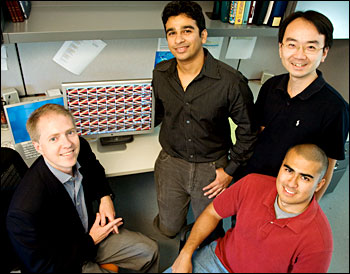
Bright Quantum Dot Record Set
CHAMPAIGN, Ill., Sept. 25, 2007 -- Enhanced fluorescence intensity has been demonstrated by a factor of up to 108 by placing quantum dots on a specially designed photonic crystal. Potential applications include high-brightness LEDs, optical switches and personalized, high-sensitivity biosensors.
"We are using photonic crystals in a new way," said Brian Cunningham, a professor of electrical and computer engineering and a corresponding author of a study by researchers at the University of Illinois who demonstrated the results. "We tune them to the specific wavelength of a laser used to stimulate the quantum dots, which couples the energy more efficiently and increases the brightness."

Left to right: Brian Cunningham, a professor of electrical and computer engineering at the University of Illinois at Urbana-Champaign, and graduate students Nikhil Ganesh, Wei Zhang and Patrick Mathias have set a new record for the brightness of quantum dots. (Photo: L. Brian Stauffer, courtesy University of Illinois at Urbana-Champaign)
A quantum dot is a tiny piece of semiconductor material 2 to 10 nms in diameter (a nanometer is 1 billionth of a meter). When illuminated with invisible ultraviolet light, a quantum dot will fluoresce with visible light.
To enhance the fluorescence, Cunningham and colleagues begin by creating plastic sheets of photonic crystal using a technique called replica molding. Then they fasten commercially available quantum dots to the surface of the plastic.
"We designed the photonic crystal to efficiently capture the light from an ultraviolet laser and to concentrate its intensity right within the surface where the quantum dots are located," said Cunningham, who also is affiliated with the university's Beckman Institute, the Micro and Nanotechnology Laboratory and the Institute for Genomic Biology. "Enhanced absorption by the quantum dots is the first improvement we made."
Enhanced, directed emission from the quantum dots is the second improvement.
Quantum dots normally give off light in all directions. However, because the researchers' quantum dots are sitting on a photonic crystal, the energy can be channeled in a preferred direction -- toward a detector, for example.
While the researchers report an enhancement of fluorescence intensity by a factor of up to 108 compared with quantum dots on an unpatterned surface, more recent (unpublished) work has exceeded a factor of 550, the university said in a statement.
The enhanced brightness makes it feasible to use photonic crystals and quantum dots in biosensing applications from detecting DNA and other biomolecules, to detecting cancer cells, spores and viruses, Cunningham said. More exotic applications, such as personalized medicine based on an individual's genetic profile, may also be possible.
The study paper is published in the August issue of the journal Nature Nanotechnology. Funding was provided by the National Science Foundation and SRU Biosystems. Part of the work was carried out in the university's Center for Microanalysis of Materials, which is partially supported by the US Department of Energy.
For more information, visit: www.uiuc.edu
Published: September 2007